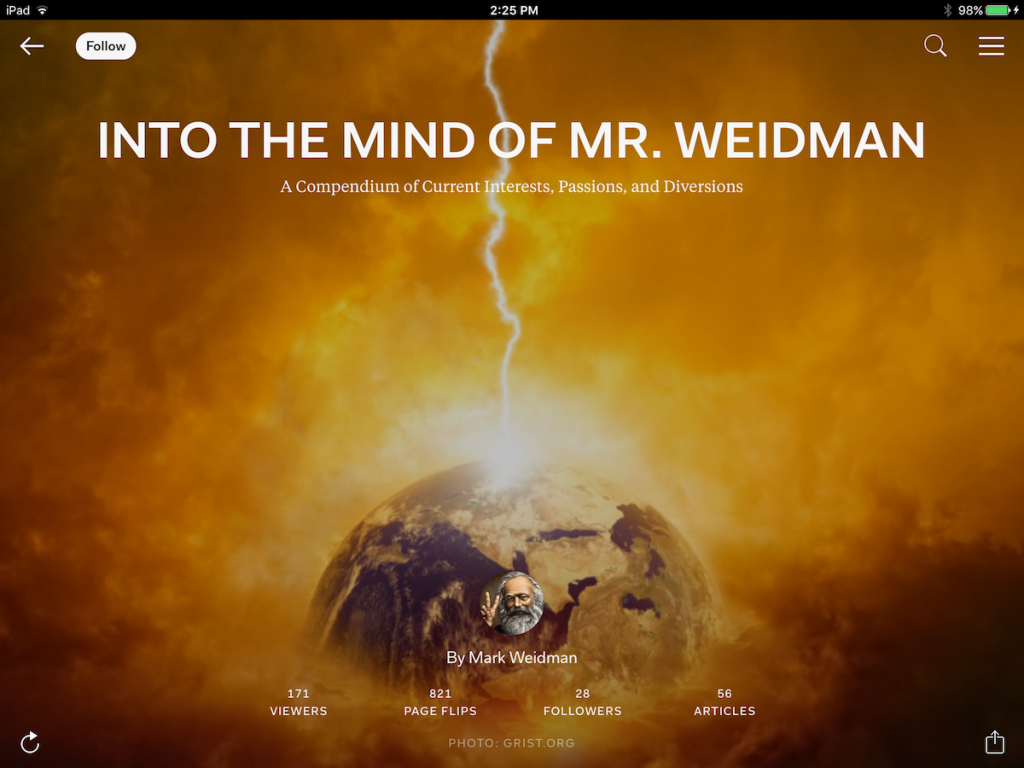Mark Weidman of Los Osos High School in Rancho Cucamonga, CA. Photo courtesy of Mark Weidman.[/caption] Mark Weidman is a veteran of the high school English classroom, 25 years and counting. He currently teaches at one of the highest-rated public high schools in California—Los Osos High School in Rancho Cucamonga, CA. “I’m very fortunate to work with students who value their education, and with parents who support their kids and our school,” he says. “Like many veteran (read: old) teachers, I try to find ways to introduce useful, academically-oriented technology into my classroom. All my students have smartphones or a device, and all are literate in their use. We all sense that the future of education will be infused with greater amounts of technology, and much of it will be based on internet platforms, and we (my students and me) are all looking for ways to get there. For me, Flipboard is a kind of gateway to internet-based education.” In terms of using Flipboard in his classroom, Weidman says he’s been “flying by the seat of my pants” and yet he’s come up with so many clever uses both in and out of the classroom. He counts the ways Flipboard Magazines have served him, his students and his community.
- To get to know me, the teacher: I started the year by making a Flipboard magazine called “Into the Mind of Mr. Weidman,” and introduced myself to each class by displaying this Flipboard for them and saying a little bit about the articles inside. I populated the mag with articles, images, videos, and I think a song or two.

- To get to know my students: Next, students were asked to do the same thing: make a Flipboard of resources reflecting their own particular interests, values, and concerns. In turn, each student spent a few minutes in front of the class talking about herself or himself in a personal but academic way. (Here’s an example.)
- To collect supplemental readings: I also used Flipboard to put together magazines of resources related to our study of specific texts, such as Animal Farm/Utopianism and Lord of the Flies.
- To highlight extracurricular activities: Later in the semester, students wrote articles about their involvement in a school club, sport or performance group. These articles were collected into classroom Flipboard Magazines. I love this because these are whole Flipboards made of student-written, original content!
- To showcase our school: I then assembled the best of these articles, across all my classes, and created a Flipboard Magazine that presented our kids and our school in a very positive light. The presentational style—flipping pages—makes these magazines all the more enjoyable to read, and make parents and teachers PROUD.
[caption id="attachment_29101" align="aligncenter" width="1024"]
 Photo courtesy of Mark Weidman.[/caption]
Photo courtesy of Mark Weidman.[/caption]
- To inspire other teachers: In January I presented Flipboard to teachers at my school. I shared with them what my students had created and they were pumped! I even got a few them creating their own magazines by the end of the workshop. Flipboard is easy to use and empowering for readers and teachers.
- To package my honors students’ work: My sophomore honors students give TED talks at the end of second semester, and these talks are recorded and posted on our Talk Project 2016. I have already created a Talk Project 2016 Flipboard within which I will feature videos of students delivering their talks.
- To pursue my interests: I also have magazines I share with my family, my wife, and my fellow teachers. My favorite is Postcapitalism, a magazine I made of resources related to our classroom study of the Paul Mason article “The end of capitalism has begun,” published in The Guardian. I just kept adding resources to it, articles and images and videos, and now Postcapitalism has over 800 followers! Working on this magazine has taught me how to create themes or tropes within Flipboard, and how to use families of images, spaced accordingly throughout the mag, to establish tone. I am very interested in continuing to discover new ways to organize content within a Flipboard magazine.



 Photo courtesy of Mark Weidman.[/caption]
Photo courtesy of Mark Weidman.[/caption]